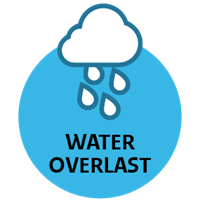What can we do to combat waterlogging?
Waterlogging cannot always be prevented. However, proper preparation can prevent extreme or prolonged precipitation from causing major damage or social disruption. We can prepare for waterlogging at several levels or layers; this is referred to as multi-layer safety. This page provides more information. It also explains how we are joining forces with other countries to combat waterlogging in larger catchment areas.
Multi-layer safety
In their final report, the Waterlogging and Flood Policy Platform described the levels at which we can prepare for waterlogging. The three existing layers of multi-layer safety have been expanded to five layers: water awareness, prevention, impact reduction, crisis control and restoration. See the paragraphs below for more details on these five layers, and click on the link below each layer to read how the Netherlands is combating waterlogging at that level.
Basic layer: Water-conscious behaviour
This basic layer is focused on raising awareness of the risks entailed in waterlogging for residents and businesses.
Read more about the basic layer: Water awareness
Layer 1: Prevention in the water system
Prevention involves reducing the probability of waterlogging and flooding. For example, the probability of waterlogging can be reduced by using the soil as a sponge. The probability of flooding is minimised through robust flood defences, which constitute the basis of our flood protection system.
Read more about layer 1: Prevention
Layer 2: Impact reduction through spatial planning
The impact of extreme waterlogging or flooding is reduced by designing the built environment in a sustainable manner. This is also referred to as impact reduction through spatial planning.
Read more about layer 2: Impact reduction through spatial planning
Layer 3: (Preparing for) crisis control
Crisis control involves improving disaster control, for example, by drawing up smart evacuation plans.
Read more about layer 3: Crisis control
Layer 4: Water-resilient restoration
Restoration is focused on re-designing an affected area in order for it to be better prepared for future periods of extreme weather.
Read more about layer 4: Climate-resilient restoration
International collaboration
Extensive collaboration to combat waterlogging and flooding is not just under way within the Netherlands; we are also joining forces with other countries.
- JCAR ATRACE is an international network of knowledge institutes that are collaborating on a knowledge bank to expedite and improve applied research in the field of flooding and drought management. Wherever possible, the researchers are collaborating with policy makers and other parties involved in the work in practice. The studies are mainly focused on enabling regional governments in Belgium, Germany, Luxembourg and the Netherlands to better prepare their catchment areas for extreme climate events.
- Under the Intensification of Cross-border Collaboration Programme (IGOS), Dutch provinces and district water boards seek to strengthen collaboration with neighbouring countries such as Belgium and to collectively conduct stress tests and review potential measures.
- Blue Deal: a programme set up by the Dutch district water boards, the Ministry of Foreign Affairs and the Ministry of Infrastructure and Water Management. The programme is intended to give 20 million people across the globe access to sufficient, clean and safe water. The Blue Deal will run up to and including 2030 and comprises 17 partnerships in 14 countries.
- European Floods Directive: EU member states have joined forces to minimise the impact of flooding. This collaboration has resulted in, among other things, the Water Resilience Strategy.
